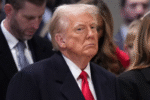The Director of National Intelligence (DNI) Tulsi Gabbard now states that Iran could produce nuclear weapons “within weeks,” a significant shift from her testimony to Congress just three months ago where she asserted Iran was not producing such weapons.
Gabbard claims her March testimony – in which she said Iran had material stockpiles but was not producing weapons – was taken out of context by “dishonest media,” according to the BBC.
Her change in stance follows Donald Trump’s assertion that she was “mistaken” and that intelligence indicated Iran possessed an “enormous amount of material” and could have nuclear weapons “within months.”
Iran’s Stance and Trump’s Ultimatum
Iran has consistently maintained that its nuclear program is entirely peaceful and has never sought to develop nuclear weapons.
On Thursday, Trump stated he was giving Tehran a “maximum” of two weeks to reach an agreement on its nuclear activities with Washington. He added that he would soon decide whether the US should join Israeli strikes on Iran. This issue has reportedly caused significant disagreements within Trump’s MAGA movement.
On Saturday morning, Iranian Foreign Minister Abbas Araghchi declared that his country is “absolutely ready for a negotiated solution” on its nuclear program, but stressed that Iran “cannot go through negotiations with the U.S. when our people are being bombed.”
Intelligence Assessment and International Concerns
In her social media post, Gabbard said that US intelligence assessments show Iran is “at a point where it can produce nuclear weapons within weeks to months.” She added, “President Trump has made it clear that cannot happen, and I concur.”
Gabbard also shared a video of her full congressional testimony from March, where she noted that US intelligence agencies had concluded Iran was not producing nuclear weapons. She also stated that experts determined Iran had not restarted its halted 2003 nuclear weapons program, even as the country’s stockpiles of enriched uranium—a component of such weapons—were at record highs. In her testimony, she had called Iran’s stockpiles “unprecedented for a non-nuclear weapons state.”
Earlier this month, the International Atomic Energy Agency (IAEA), the global nuclear watchdog, expressed concern over Iran’s enriched uranium stockpiles, which can be used for reactor fuel but also for nuclear weapons.
Trump had previously criticized Gabbard’s March testimony, telling reporters he “didn’t care what she says.” The US president said he believes Iran is “very close to having a weapon” and that his country will not allow that to happen.
Escalating Conflict and Casualties
In 2015, Iran reached a long-term agreement on its nuclear program with a group of world powers after years of tension over the country’s alleged efforts to develop nuclear weapons.
Iran had been holding talks with the US this year regarding its nuclear program and was scheduled for another round when Israel launched attacks on Iran on June 13. Israeli Prime Minister Benjamin Netanyahu stated these strikes were aimed at the “heart” of Iran’s nuclear program, claiming that “if not stopped, Iran could produce nuclear weapons in a very short time.”
Israeli airstrikes have destroyed Iranian military facilities and weapons, and high-ranking military commanders and nuclear scientists have been killed. Iran’s Ministry of Health reported on Saturday that at least 430 people have died, while a human rights group, the Human Rights Activists News Agency, estimated an unofficial death toll of 657 on Friday. Iran has retaliated with missile and drone attacks on Israel, resulting in 25 deaths, including one person who suffered a heart attack.







